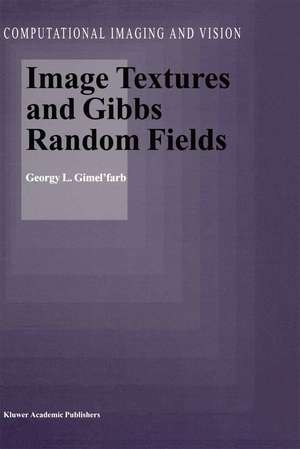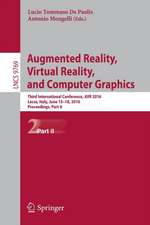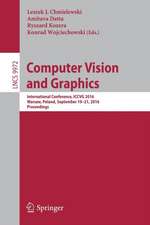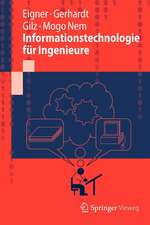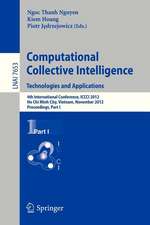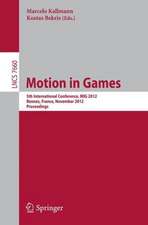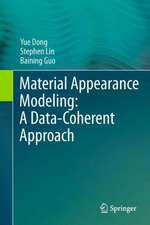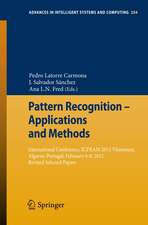Image Textures and Gibbs Random Fields: Computational Imaging and Vision, cartea 16
Autor Georgy L. Gimel'farben Limba Engleză Paperback – 14 oct 2012
Din seria Computational Imaging and Vision
- 20%
 Preț: 658.52 lei
Preț: 658.52 lei - 20%
 Preț: 993.09 lei
Preț: 993.09 lei - 20%
 Preț: 648.59 lei
Preț: 648.59 lei - 15%
 Preț: 654.62 lei
Preț: 654.62 lei - 5%
 Preț: 736.03 lei
Preț: 736.03 lei - 5%
 Preț: 374.20 lei
Preț: 374.20 lei - 15%
 Preț: 583.24 lei
Preț: 583.24 lei - 20%
 Preț: 653.71 lei
Preț: 653.71 lei - 18%
 Preț: 1224.36 lei
Preț: 1224.36 lei - 15%
 Preț: 665.73 lei
Preț: 665.73 lei - 20%
 Preț: 593.48 lei
Preț: 593.48 lei - 20%
 Preț: 651.57 lei
Preț: 651.57 lei - 20%
 Preț: 653.38 lei
Preț: 653.38 lei - 20%
 Preț: 657.83 lei
Preț: 657.83 lei - 5%
 Preț: 671.02 lei
Preț: 671.02 lei - 20%
 Preț: 373.21 lei
Preț: 373.21 lei - 20%
 Preț: 351.69 lei
Preț: 351.69 lei - 20%
 Preț: 650.59 lei
Preț: 650.59 lei - 20%
 Preț: 996.40 lei
Preț: 996.40 lei - 20%
 Preț: 558.56 lei
Preț: 558.56 lei - 5%
 Preț: 737.11 lei
Preț: 737.11 lei - 15%
 Preț: 657.39 lei
Preț: 657.39 lei - 20%
 Preț: 344.60 lei
Preț: 344.60 lei - 15%
 Preț: 654.43 lei
Preț: 654.43 lei -
 Preț: 411.80 lei
Preț: 411.80 lei - 20%
 Preț: 341.63 lei
Preț: 341.63 lei - 20%
 Preț: 360.60 lei
Preț: 360.60 lei
Preț: 331.08 lei
Preț vechi: 413.85 lei
-20% Nou
Puncte Express: 497
Preț estimativ în valută:
63.35€ • 66.31$ • 52.73£
63.35€ • 66.31$ • 52.73£
Carte tipărită la comandă
Livrare economică 31 martie-14 aprilie
Preluare comenzi: 021 569.72.76
Specificații
ISBN-13: 9789401059121
ISBN-10: 9401059128
Pagini: 268
Ilustrații: XIV, 251 p.
Dimensiuni: 160 x 240 x 14 mm
Greutate: 0.38 kg
Ediția:Softcover reprint of the original 1st ed. 1999
Editura: SPRINGER NETHERLANDS
Colecția Springer
Seria Computational Imaging and Vision
Locul publicării:Dordrecht, Netherlands
ISBN-10: 9401059128
Pagini: 268
Ilustrații: XIV, 251 p.
Dimensiuni: 160 x 240 x 14 mm
Greutate: 0.38 kg
Ediția:Softcover reprint of the original 1st ed. 1999
Editura: SPRINGER NETHERLANDS
Colecția Springer
Seria Computational Imaging and Vision
Locul publicării:Dordrecht, Netherlands
Public țintă
ResearchCuprins
Instead of introduction.- 1 Texture, Structure, and Pairwise Interactions.- 1.1 Human and computational views.- 1.2 Spatial homogeneity, or self-similarity of textures.- 1.3 Basic notation and notions.- 1.4 Random fields and probabilistic image modelling.- 1.5 Physics and image modelling: what an interaction means.- 1.6 GPDs and exponential families of distributions.- 1.7 Stochastic relaxation and stochastic approximation.- 2 Markov and Non-Markov Gibbs Image Models.- 2.1 Traditional Markov/Gibbs image models.- 2.2 Generalized Gibbs models of homogeneous textures.- 2.3 Prior Markov/Gibbs models of region maps.- 2.4 Piecewise-homogeneous textures.- 2.5 Basic features of the models.- 3 Supervised MLE-Based Parameter Learning.- 3.1 Affine independence of sample histograms.- 3.2 MLE of Gibbs potentials.- 3.3 Analytic first approximation of potentials.- 3.4 Most characteristic interaction structure.- 3.5 Stochastic approximation to refine potentials.- 4 Supervised Conditional MLE-Based Learning.- 4.1 The least upper bound condition.- 4.2 Potentials in analytic form.- 4.3 Practical consistency of the MLEs.- 5 Experiments in Simulating Natural Textures.- 5.1 Comparison of natural and simulated textures.- 5.2 “Brodatz” image database.- 5.3 Interaction maps and texture features.- 5.4 CSA vs. traditional modelling scenario.- 5.5 “MIT VisTex” image database.- 6 Experiments in Retrieving Natural Textures.- 6.1 Query-by-image texture retrieval.- 6.2 Similarity under scale and orientation variations.- 6.3 Matching two textures.- 6.4 Experiments with natural textures.- 6.5 Complexity and practicality.- 7 Experiments in Segmenting Natural Textures.- 7.1 Initial and final segmentation.- 7.2 Artificial collages of Brodatz textures.- 7.3 Natural piecewise-homogeneous images.- 7.4How to choose an interaction structure.- 7.5 Do Gibbs models learn what we expect?.- Texture Modelling: Theory vs. Heuristics.- References.
